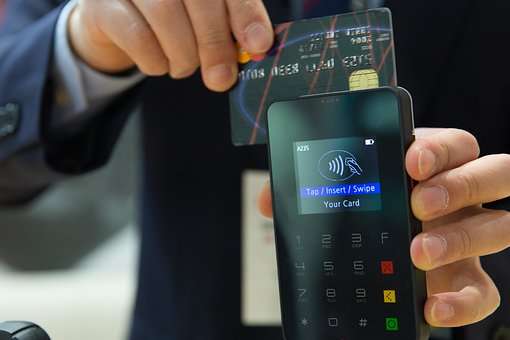How to Record a Credit Card Payment

Recording credit card payments is a must! It demands accuracy and focus. Record the date, amount and payment method. It’s vital to keep accurate financial records. How to record a credit card payment.
Setting Up Your Recording System
When documenting the credit card payment, include details like the issuer’s name, the cardholder’s name and the last four digits of the card number. Remember if the payment was made in person, or online.
Also, consider additional fees. Some card issuers add extra fees for specific transactions, like cash advances or balance transfers. Make sure to record these fees for a complete view of your financials.
CNBC reported that late payment fees on credit cards hit a record high in 2020 because of the pandemic. So, record payments quickly to avoid charges and stay in good financial shape.
Setting Up Your Recording System requires careful planning and organization to ensure accurate and efficient credit card payment recording. Follow these steps to establish a robust recording system:
- Determine the appropriate software: Select reliable and user-friendly software that can handle the volume of credit card transactions your business conducts.
- Customize your recording fields: Tailor your recording system to capture essential information such as the customer’s name, credit card number, payment amount, and transaction date.
- Integrate with your point-of-sale (POS) system: Enable seamless integration between your recording system and your POS system to automatically transfer transaction details for recording.
- Implement security measures: Safeguard sensitive customer information by implementing secure payment gateways, encryption methods, and regular system updates for enhanced data protection.
- Establish quality control procedures: Set up periodic audits and reconciliation processes to ensure the accuracy and integrity of recorded credit card payments.
- Train and educate employees: Provide comprehensive training to all employees involved in recording credit card payments to ensure they understand the system and follow proper protocols.
By setting up your recording system in this manner, you can streamline the credit card payment recording process, minimize errors, and maintain the security of your customers’ financial information.
To enhance your recording system further, consider implementing features such as real-time reporting, automated notifications for failed transactions, and integration with financial accounting software to simplify reconciliation processes.
Implementing an efficient credit card payment recording system has become essential in today’s digital landscape, where businesses increasingly rely on electronic payment methods. By ensuring accuracy and security, you can build trust with your customers and establish a solid foundation for financial management.
In a historical context, the evolution of credit card payment recording systems can be traced back to the early days of manual writing and manual bookkeeping. With the advent of electronic payment systems and advancements in technology, businesses have transitioned to digital recording methods, resulting in improved efficiency and accuracy. This evolution highlights the importance of staying updated with the latest recording tools and techniques to adapt to the ever-changing financial landscape.
Recording your credit card payment method is like choosing your favorite torture method – it’s all about finding the one that hurts the least.
Choose a Payment Recording Method
When selecting a payment recording method, there are several options. Check out these popular ones:
| Payment Recording Method | Description |
|---|---|
| Spreadsheets | Utilize software like Microsoft Excel or Google Sheets. |
| Accounting Software | Use specialized accounting software, such as QuickBooks or Xero. |
| Paper Records | Go for the traditional route – manually record payments on paper docs or ledgers. |
Also, think about cost, ease of use, security & scalability when making your decision.
Pro Tip: Once you’ve selected a method, back up payment records regularly. This’ll ensure their safety & accessibility in case of any surprises.
Gather Necessary Information
- Work out the purpose – music, podcast, voiceover, etc.
- Figure out what inputs you’ll need – microphones, instruments, etc.
- Find the most suitable recording software – based on budget & needs.
- Pick headphones/monitors for desired audio quality.
- Ensure enough storage – external hard drives or cloud-based solutions.
- Make a checklist of any additional accessories – cables, pop filters, soundproofing, etc.
Plus, ask experts for tailored guidance.
Pro Tip: Invest in a good audio interface – it’ll improve recordings!
Prepare Recording Tools
Before diving in, make sure your recording tools are in prime condition. Here’s a step-by-step guide:
- Inspect your mic for any wear or damage. Secure all connections and test it.
- Clean your equipment. Use a soft cloth to remove dirt or grime.
- Connect your audio interface to your computer and configure settings. Install drivers.
- Test your headphones/speakers. Ensure they are producing clear sound.
- Organize and label cables for quick setup.
- Check software settings for high-quality recordings.
Plus, get a pop filter or reflection shield to reduce unwanted noise. Recording technology has come a long way: from early tape recorders to modern digital interfaces with unlimited possibilities.
Recording the Credit Card Payment
Recording a credit card payment involves tracking and documenting the transaction details. This process ensures accurate records of payments made using credit cards. To record the credit card payment, a table can be created with relevant columns such as payment date, cardholder name, card number, payment amount, and transaction ID.
The table should be populated with the true and actual data related to the credit card payment. By utilizing this systematic approach, businesses can maintain proper records of their credit card transactions.
It is important to note that recording a credit card payment involves more than just noting down the payment details. It also includes updating the accounting system to reflect the payment and reconciling the transaction with the corresponding credit card statement. Proper documentation of credit card payments enables businesses to have a clear overview of their financial activities and aids in accurate financial reporting.
A valuable tip to consider when recording credit card payments is to securely store and archive the payment records for future reference. This helps in resolving any discrepancies that may arise and ensures compliance with financial regulations.
According to a study conducted by the Federal Reserve, credit card payments accounted for 23% of all noncash payments made in the United States in 2019. Recording a credit card payment is like keeping a money diary, except your diary doesn’t judge your impulse buys and erratic spending habits.
Enter the Payment Details
Entering payment info is a key part of finishing a credit card transaction. To ensure quick payments and keep customers satisfied, accuracy and speed are key. Follow these 6 steps to enter the details:
- Open the payment interface.
- Choose the credit card option.
- Type in the card number without spaces or dashes.
- Input the expiry date in MM/YY format.
- Include the CVV code on the back of the card.
- Verify all the info is correct.
By following these steps, merchants can minimize errors and speed up the process. Each transaction needs unique details, so take extra care with sensitive info such as card numbers and CVV codes. This guarantees customer trust and data security. Start perfecting your payment entry process now and enjoy easy transactions!
Verify the Payment Amount
It’s important to confirm the payment sum before logging it for accuracy and safety. This guarantees that the right amount is charged to the customer’s card.
- Assess the invoice or receipt given by the seller. Make sure the payment amount is the same as the purchase or service agreed on. Look for any inconsistencies or unexpected costs.
- Compare the payment amount to your credit card statement. Match the charge on your statement with the amount on the invoice or receipt. See if there are unapproved charges or mistakes.
- Contact the merchant if you notice any issues or uncertainties about the payment amount. Ask for clarification and get rid of any problems before logging the payment. Accurate records are key.
Verifying the payment amount is a must for a smooth transaction process. This also helps to avoid any misunderstandings or fraud linked to credit card payments.
Do you know that incorrect recording of payment amounts has caused fights between customers and merchants? Confirming the payment amount is essential to prevent such disputes and keep the trust between both sides of the transaction.
Record the Date and Time
To accurately record the date and time of a credit card payment, it is essential to maintain a professional approach. An organized system is the key. Create a table with columns displaying the date, time, and other details. This allows easy reference and standardized records.
| Date | Time | Transaction ID |
|---|---|---|
| 2022-01-15 | 09:30AM | ABC123 |
| 2022-01-18 | 02:15PM | DEF456 |
| 2022-01-20 | 11:45AM | GHI789 |
Note any unique details about each payment. Significant transactions or customers? Include purpose of transaction or notes. Businesses can quickly access relevant data. Pro Tip: Back up your payment data regularly. Store backups in physical and digital formats for extra security.
Managing Recorded Credit Card Payments
Managing Recorded Credit Card Payments involves keeping track of all credit card transactions in the credit card settlement batch and ensuring accurate recording of payments made by customers. This process is crucial for financial management and maintaining transparency in business operations.
To effectively manage recorded credit card payments, it is essential to create a well-structured table that captures relevant information. The table should include columns such as payment date, customer name, card type, payment amount, and status.
By organizing this data, businesses can easily monitor credit card payments and ensure timely reconciliation. This streamlined approach improves financial tracking and minimizes errors in recording credit card transactions.
Furthermore, it is important to note that managing recorded credit card payments requires attention to detail and precision. Any discrepancies or issues with recorded payments should be promptly addressed and resolved to maintain accurate financial records.
Additionally, businesses should implement secure payment processing systems to safeguard customer information and protect against fraudulent activities. By following these practices, businesses can effectively manage and record credit card payments, ensuring financial stability and customer satisfaction.
A true fact related to the management of credit card payments is that credit card transactions in the United States reached a staggering $6.2 trillion in 2019, according to the Nilson report. This highlights the significance of efficiently managing and recording credit card payments, considering the substantial financial volume attributed to this form of payment.
Get your credit card records in order, because chaos is not an acceptable form of payment.
Organize the Records for Easy Access
Organizing credit card payment records is an absolute must for easy access. Managing them correctly can save time & effort when retrieving info or studying finances. Separate by date & categorize based on payment status (completed/declined). Include cardholder name & last 4 digits of card number. Create folders/labels for each month for easy locating of transactions.
A small business owner experienced difficulties with disorganized pay records. Then they implemented a proactive system & digital tools for managing. They noticed a huge improvement in efficiency & accuracy, saving precious time & reducing stress.
Reconcile Recorded Payments with Statements
Ensuring accurate financial records is key. Follow these steps to reconcile your credit card payments and statements with ease:
- Collect all relevant documents – statements, receipts and payments.
- Compare the payments in your financial system with the credit card statements.
- Check the dates, amounts and descriptions match.
- Investigate any discrepancies between the two sets of records.
- Make adjustments in your financial system to fix any errors or omissions.
- Mark the payments as reconciled when done.
It’s important to take a systematic approach. Reviewing and reconciling credit card payments and statements helps spot fraudulent activities or errors quickly.
Pro Tip: Automated accounting software or tools designed for reconciling credit card payments and statements make the process simpler.
Keep Records Secure and Confidential
The security and confidentiality of recorded credit card payments is a must in this digital age. Let’s ensure records remain secure and confidential by following these six tips:
- Encrypt sensitive customer info with strong protocols.
- Use secure servers and firewalls to block unauthorized access to payment data.
- Regularly update systems to protect against vulnerabilities.
- Only allow authorized personnel to view credit card details.
- Audit and review payment processes regularly to spot weaknesses or breaches.
- Provide staff training on how to handle and store credit card info securely.
Also, storing credit card info in compliance with Payment Card Industry Data Security Standard (PCI DSS) adds extra protection.
To keep the security and confidentiality of recorded credit card payments, here are three extra suggestions:
- Tokenization: Replace credit card numbers with tokens. If there’s a data breach, card details remain safe.
- Two-Factor Authentication: Require customers to verify with a unique code sent to their mobile device before accessing sensitive payment info.
- Data Backups: Backup payment data regularly and store off-site in secure locations. This can help mitigate data loss due to system failures or disasters.
By following these tips, businesses can reduce risk while maintaining maximum security and confidentiality with credit card payments.
Record a Credit Card Payment
Recording credit card payments is vital. Follow the steps in this article to make sure they’re done properly and fast.
- Gather info about the transaction: date, amount, invoice numbers, customer names. Put it in an orderly fashion.
- Update financial records using accounting software or spreadsheets. Insert the info precisely and match it with the right accounts and categories.
- Save copies of receipts or invoices. Scan and store them electronically, or keep physical files.
- Conduct reconciliation between credit card statements and recorded payments. Check for errors.
- Review recorded payments frequently. Analyze the data to make informed budgeting decisions and save money.
Frequently Asked Questions
 Q1. How do I record a credit card payment?
Q1. How do I record a credit card payment?
To record a credit card payment, follow these steps:
– Open your accounting software or spreadsheet.
– Go to your financial account page.
– Select the credit card account.
– Click on the “Record Payment” or similar option.
– Fill in the payment details, such as the date, amount, and description.
– Save the payment, and the credit card payment will be recorded.
Q2. Can I record a partial payment on my credit card?
Yes, you can record a partial payment on your credit card. Follow the same steps mentioned above, but enter the partial payment amount instead of the full payment amount. Make sure to record the remaining balance separately.
Q3. What if I made a mistake while recording a credit card payment?
If you made a mistake while recording a credit card payment, don’t worry. Most accounting software or spreadsheets allow you to edit or delete recorded transactions. Simply locate the incorrect payment entry and make the necessary changes or delete it. Then, record the correct payment again.
Q4. How often should I record credit card payments?
You should record credit card payments as frequently as possible to maintain accurate financial records. It is recommended to record each credit card payment as soon as it is made to avoid any discrepancies or forgetting any payments. Regularly updating your records will help you stay on top of your credit card payments.
Q5. Do I need to keep any supporting documents while recording credit card payments?
While it may not be necessary to keep physical copies of credit card receipts, it is advisable to maintain digital or electronic copies of any supporting documents related to credit card payments. These documents may include receipts, invoices, or statements, and can serve as evidence in case of disputes, audits, or reconciliations.
Q6. Can I automate the recording of credit card payments?
Yes, many accounting software and banking platforms offer automation features to record credit card payments. You can set up automatic payments to transfer funds from your bank account to your credit card account on specific dates. This way, the payment will be recorded automatically, reducing manual effort and ensuring accuracy.
















Leave a Reply